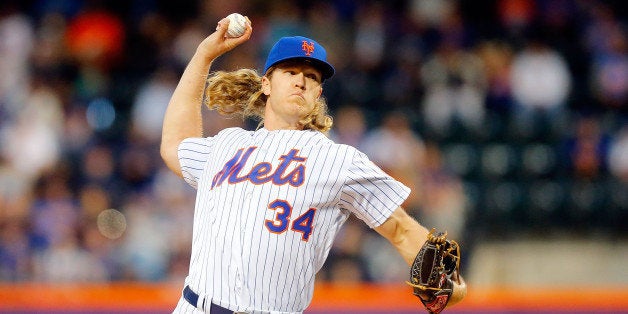
Welcome back to the fantasy baseball classroom, where we discuss advanced stats that help us dominate. Previous lessons have been focused on hitters, as we've explored BABIP as well as hard-hit rates. Now we turn our attention to pitchers and their SIERA.
Why should I care about SIERA?
You're probably familiar with ERA (Earned Run Average). Well SIERA takes that further, standing for "Skill-Interactive Earned Run Average". It was created to quantify how well a pitcher has truly performed based on, well, their skills. That's rather ambiguous, so let's wade in a little with a case study.
Scenario A: Pitcher A strikes out the side, notching a 0.00 ERA.
Scenario B: Pitcher B gives up a double, a single, and a walk to load the bases. He then gives up a hard line drive that is hit at his right fielder, who starts a triple play. Pitcher B also gets a 0.00 ERA for this.
Clearly Pitcher A performed very well while Pitcher B got lucky, yet their ERA says they're the same. This example is hyperbolic, but Scenario B actually happened on April 22. The takeaway is that ERA leaves much to be desired when it comes to analyzing true talent.
What is SIERA?
First, a brief history lesson. Voros McCracken set out hoping to find a way to judge pitchers based on things that were in their control. That meant strikeouts, walks and home runs. Perhaps you've heard of FIP (Fielding Independent Pitching) and xFIP (FIP, but with a league-average home run rate allowed assumed). SIERA takes the next step as batted-ball data has become widely available. It incorporates the kind of contact a pitcher allows into the formula, the entirety of which can be viewed here.
SIERA looks at strikeouts and walks, but takes it a step further by positing that a high-strikeout pitcher usually induces weaker contact thanks to his swing-and-miss stuff. With walks, SIERA says a pitcher with better control is less "hurt" by issuing one walk.
Most importantly, SIERA takes into account each pitcher's batted-ball profile. If a pitcher gives up more grounders or more fly balls, then SIERA will use that to grade outcomes. These little tweaks may not sound like much, but in this world even the slightest step towards a more accurate metric makes for a huge advantage.
SIERA is also a park-adjusted metric, accounting for a pitcher calling mile-high Coors Field home versus one who pitches in spacious Safeco Field. ESPN's Park Factors does well to provide a baseline for which stadiums are hitter or pitcher friendly.
2015 SIERA Leaders and Early 2016 Notables
Let's provide some context from a full season's worth of data. Here's your top-10 in SIERA from last season, along with their ERA:
1.Clayton Kershaw - 2.24 SIERA, 2.13 ERA.
2.Chris Sale - 2.52 SIERA, 3.41 ERA.
3.Max Scherzer - 2.63 SIERA, 2.79 ERA.
4.Carlos Carrasco - 2.74 SIERA, 3.63 ERA.
5.Jake Arrieta - 2.75 SIERA, 1.77 ERA.
6.Dallas Keuchel - 2.84 SIERA, 2.48 ERA.
7.Corey Kluber - 2.98 SIERA, 3.49 ERA.
8.Jacob deGrom - 2.99 SIERA, 2.54 ERA.
9.Madison Bumgarner - 3.00 SIERA, 2.93 ERA.
10.Chris Archer - 3.08 SIERA, 3.23 ERA.
Last year's ERA leader is absent. Zack Greinke had a 1.66 ERA with a 3.27 SIERA (tied for 14th). This led many to see regression coming in 2016, although no one saw the 6.16 ERA coming through his first five starts. His SIERA sits at 3.93 thus far. He certainly is not this bad, just as his true talent level wasn't that amazing last season.
Not good enough for you? Well let's use No. 4 up there, Carlos Carrasco, to show how this can help midseason. Through the first half of the season Carrasco had a 4.07 ERA that overshadowed a 2.90 SIERA. He went on to post a 2.99 ERA the rest of the way.
On the flipside, Yovani Gallardo had a 2.62 ERA through the first half last season, though his 4.40 SIERA pointed to the 4.69 second half ERA that he churned out. You better believe that we use metrics such as SIERA to determine who we recommend to readers in our Sleepers and Waiver Wire Pickups list.
Early 2016 SIERA ratings confirm that Noah Syndergaard has been amazing, as his 1.83 SIERA is No. 1. Here are some intriguing names towards the top of the list: Rich Hill (2.57), Taijuan Walker (2.64), and Drew Smyly (2.67), Rick Porcello (2.72), Aaron Nola (2.77), and Nate Eovaldi (2.89).
SIERA also isn't buying two particularly hot starts: Mat Latos (0.74 ERA, 4.90 SIERA) and Jordan Zimmermann (0.35 ERA, 4.43 SIERA). Meanwhile, Adam Wainwright's struggles (7.25 ERA) are backed by his 5.91 SIERA. See how this can be helpful?
SIERA is a Fantastic Tool, But Isn't Perfect
Please do not read this as "SIERA is the only stat you're ever going to need, it's always right!" As always, never rely on any one metric. There are many other stats that help fill out a pitcher's profile to be explored in the coming weeks. Might I suggest soft contact generated?
Do note that there are types like Sonny Gray who have consistently outpitched their SIERA, and guys like Michael Pineda who have yet to live up to theirs. Pineda has an amazing 27:5 strikeout-to-walk ratio through 22 innings thus far, so his gorgeous 3.09 SIERA sits behind an ugly 6.95 ERA.
This is an evolving science. SIERA will probably be ousted by some metric down the line, just as it was the next step after FIP.
In the end, SIERA is one of the best available tools to analyze pitcher performance. Do they deserve that pristine ERA they're sporting? Is it likely that their 4.00 ERA is hiding something? We love targeting talent, so SIERA is very handy. Here's the leaderboard if you want to poke around. I'm always available for a second opinion as well!
